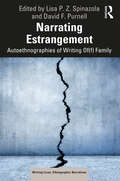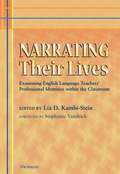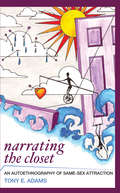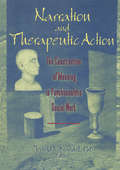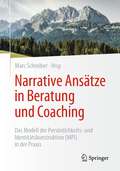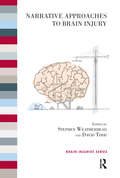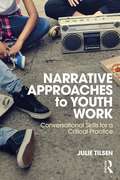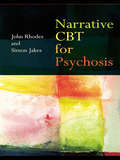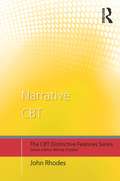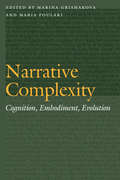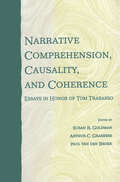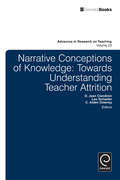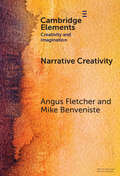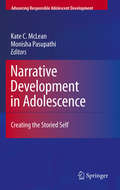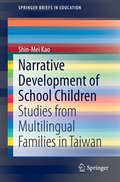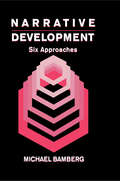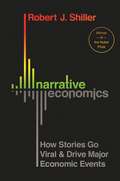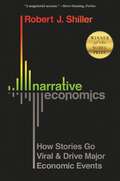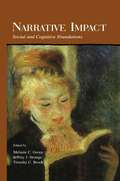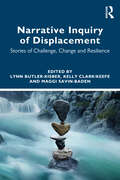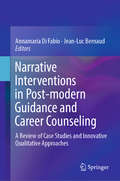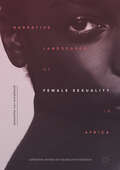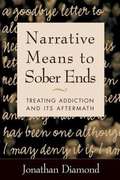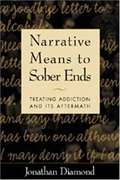- Table View
- List View
Narrating Estrangement: Autoethnographies of Writing Of(f) Family (Writing Lives: Ethnographic Narratives)
by Lisa P. Z. Spinazola David F. PurnellThe stories in Narrating Estrangement: Autoethnographies of Writing Of(f) Family demonstrate the pain, anguish, and even relief felt by those who contemplate estranging or who are estranged, whether by choice or circumstance. Despite the social assumptions persisting about the everlasting nature of family relationships, when people make the complicated and often difficult decision to disconnect from family members, they experience shame, stigma, and isolation because of social pressures to maintain those relationships at all costs. Each contributor uses the act of storytelling and the autoethnographic mode of scholarship and writing to find clarity in their individual, unique, and complex situations. Several authors’ explorations restore some of what they have lost through estrangement—such as a sense of identity, emotional health and well-being, and feelings of belonging—due to the breakdowns in social and family support systems meant to be unconditional and "permanent." The stories display the wide array of reasons why family members become estranged, delving into different types of estrangement, permanent and/or intermittent. In doing so, the writers in this book demonstrate that family relationships are neither easily categorized nor neatly ended—their impact on an individual’s life continues and changes, even in and through estrangement. This book adds to the ongoing scholarly conversations about family estrangement for students and researchers interested in autoethnography and qualitative inquiry, in a wide range of disciplines in the social sciences, healthcare, and communication studies.
Narrating Their Lives: Examining English Language Teachers' Professional Identities Within The Classroom
by Stephanie Vandrick Lia Kamhi-Stein“…a groundbreaking book that will…engage, inform, and connect with present and future teachers and teacher educators. ” ---Stephanie Vandrick, Foreword to Narrating Their Lives The field of TESOL has called attention to the ways that the issues of race and ethnicity, language status and power, and cultural background affect second language learners’ identities and, to some degree, those of teachers. In Narrating Their Lives, Kamhi-Stein examines the process of identity construction of classroom teachers so as to make connections between their personal and professional identities and their instructional practices. To do that, she has selected six autobiographical narratives from teachers who were once part of her TESL 570 (Educational Sociolinguistics) class in the MA TESOL program at California State University, Los Angeles. These six narratives cover a surprisingly wide range of identity issues but also touch on broader instructional themes that are part of teacher education programs. Because of the reflective nature of the narratives—with the teachers using their stories to better understand how their experiences shape what they do in the classroom—this volume includes provocative chapter-opening and reflective chapter-closing questions. An informative discussion of the autobiographical narrative assignment and the TESL 570 course (including supplemental course readings and assessment criteria) is also included.
Narrating the Closet: An Autoethnography of Same-Sex Attraction (Writing Lives: Ethnographic Narratives)
by Tony E AdamsMotivated by the death of his partner, Adams seeks to redefine the closet as a relational construct between all people and all sexualities. The closet is explored at each stage—entering it, inhabiting it, and coming out of it—and strategies are offered for reframing difficult closet experiences. Adams makes use of interviews, personal narratives, and autoethnography to analyze lived, relational experiences of sexuality. This is a must have for scholars and students of gender studies, qualitative research, and for any reader who has felt the closet’s reach.
Narration and Therapeutic Action: The Construction of Meaning in Psychoanalytic Social Work
by Jerrold R BrandellNarration and Therapeutic Action raises challenging questions about the limitations of science and of scientific inquiry for the practice of social work. In doing so, this innovative book calls upon clinical social workers, psychologists, and psychoanalysts to examine some of the most fundamental assumptions about the clinical process and what is “therapeutic” about it. Written by social work clinicians and theorists, the book explores the construction of meaning within the dual framework of psychoanalysis and clinical social work.Readers of Narration and Therapeutic Action will find the way in which clinical illustrations are used to articulate theoretical ideas especially useful. You will find chapters ranging from the highly abstract and theoretical to those that consider very specific dimensions of clinical process. As contributors examine various aspects of narrative theory and its relationship to psychoanalysis and clinical social work, they highlight such themes as: important theoretical contributions of psychoanalytic authors (including Roy Schafer, Donald Spence, and the French psychoanalyst Jacque Lacan) to the study of narratives how to use various frameworks, such as self psychology and multigenerational family systems theory, as a structure for analysis of clients’narratives narratives and their “fit” in psychoanalytic developmental theories the evolution of specific narratives in the context of ongoing psychoanalytically-oriented treatment the narration of traumatic experiences in dynamic psychotherapyClinical social workers, psychoanalysts, and psychologists will find Narration and Therapeutic Action filled with answers to important questions about the very nature of what is therapeutic in the psychoanalytic process and why; whether existing theory can be used with modification as a guide to the “unpacking” of the text; and if there are specific psychoanalytic theories of development better-suited to the meaning-making that occurs in the crucible of the psychoanalytic dialogue. Narration and Therapeutic Action is ideal as a guide and reference for practitioners and students of clinical social work, psychoanalysis, and clinical psychology as well as for instructors of clinical theory and practice. Readers will find abundant evidence of consensus and conflict, disparity and complementarity, and resonance and dissonance in the contributors’ diverse viewpoints. While this provides readers with support for their preexisting theoretical and clinical assumptions, it also offers a broadened perspective on other theories.
Narrative Ansätze in Beratung und Coaching: Das Modell der Persönlichkeits- und Identitätskonstruktion (MPI) in der Praxis
by Marc SchreiberIn Beratung und Coaching wird sehr häufig mit narrativen Ansätzen gearbeitet. Narrative Ansätze leiten Klient*innen dazu an, die eigene Biografie zu reflektieren und dadurch den Blick auf sich selbst sowie die eigene Identität in verschiedenen Lebensbereichen zu richten. Das vorliegende Buch beinhaltet verschiedene Methoden für die Anwendung der narrativen Psychologie in der Beratungspraxis.Dabei wird im ersten Teil des Buches das Modell der Persönlichkeits- und Identitätskonstruktion (MPI) als Grundlage für die narrativen Ansätze theoretisch hergeleitet. Auf der Basis des sozialen Konstruktionismus integriert das MPI Ansätze aus der Laufbahn- und Persönlichkeitspsychologie wie die Career Construction Theorie (CCT) von Savickas, oder die Theorie der Persönlichkeits-System-Interaktionen (PSI-Theorie) von Kuhl sowie die drei Ebenen des Selbst nach McAdams: Soziale*r Akteur*in, motivierte*r Agent*in und autobiografische*r Autor*in. Darüber hinaus nimmt das MPI Bezug zu den industriellen Revolutionen von Arbeiten 1.0 bis Arbeiten 4.0.Elf Kapitel mit narrativen Methoden für die Praxis vermitteln dazu im zweiten Teil des Buches anschauliche Beispiele für die Anwendung in Beratung und Coaching, jeweils strukturiert in einen spezifischen Theorieteil, der Erläuterung der Anwendung in der Praxis und einem Praxisbeispiel.
Narrative Approaches to Brain Injury (The Brain Injuries Series)
by Stephen WeatherheadThis book brings together narrative approaches and brain injury rehabilitation, in a manner that fosters an understanding of the natural fit between the two. We live our lives by narratives and stories, and brain injury can affect those narratives at many levels, with far-reaching effects. Understanding held narratives is as important as understanding the functional profile of the injury. This book explores ways to create a space for personal stories to emerge and change, whilst balancing theory with practical application. Despite the emphasis of this book on the compatibility of narrative approaches to supporting people following brain injury, it also illustrates the potential for contributing to significant change in the current narratives of brain injury. This book takes a philosophically different approach to many current neuro-rehabilitation topics, and has the potential to make a big impact. It also challenges the reader to question their own position, but does so in an engaging manner which makes it difficult to put down.
Narrative Approaches to Youth Work: Conversational Skills for a Critical Practice
by Julie TilsenThis is the book that youth workers who want to put into practice their desire to "meet youth where they’re at" have been waiting for. Narrative Approaches to Youth Work provides hope-filled and fresh conversational practices anchored in a critical intersectional analysis of power and a relational ethic of care. These practices help youth workers answer the all-too-common question, what do I do when I do youth work? The concepts and skills presented in this book position youth workers to do youth work in ways that honor youth agency and resistance to oppression, invite a multiplicity of possibilities, and situate youth and youth workers alike within broader social contexts that influence their lives and their relationship together. Drawing on the author’s 30-plus years of working alongside young people and training youth workers in contexts ranging from recreation centers to homeless shelters, this book provides a rich and deliberate mix of theoretical grounding, practical application, real-life vignettes, and questions for in-depth self-reflection. Throughout Narrative Approaches to Youth Work, readers hear from a wise and thoughtful squad of youth workers talking about how they strive to do socially just, accountable, critical youth work.
Narrative CBT for Psychosis
by John Rhodes Simon JakesDesigned to meet the complex needs of patients with psychosis, Narrative CBT for Psychosis combines narrative and solution-focused therapy with established techniques from CBT (cognitive behaviour therapy) into one integrated flexible approach. In this book John Rhodes and Simon Jakes bring the practitioner up-to-date, as treatment and practice evolve to draw on other therapeutic approaches, creating an approach which is client centred and non-confrontational. The book contains many tried and tested practical ideas for helping clients, with several chapters including detailed and illuminating case studies. Areas of discussion include: how to work with delusions, voices and visions working with core beliefs an exploration of narratives of past difficulties and traumas recovery and ending therapy Narrative CBT for Psychosis will be essential reading for all mental health professionals who deal with psychosis who wish to learn a new approach.
Narrative CBT: Distinctive Features (CBT Distinctive Features)
by John RhodesThe popularity of using narrative, metaphor and building solutions in CBT has increased in recent years. Narrative CBT, part of the third wave of cognitive therapies, recognises the importance of helping to build new ideas and practices in order to create change, examining a person’s multiple and evolving narratives and their behaviour as intrinsically meaningful. In Narrative CBT, John Rhodes presents the features of NCBT in thirty key points. The first fifteen summarise how the theory of narrative can clarify difficulties with emotions, motives and interactions and address how rebuilding confidence and trust is crucial for change to be achieved. In the second half of the book, case conceptualisation and the techniques of NCBT are explained and illustrated. Narrative, solution-orientated and CBT techniques are integrated and specific NCBT approaches for trauma, depression and OCD are highlighted. Ideal for clinical and counselling psychologists, both established and in training, psychotherapists and all professionals carrying out therapy in the field of mental health, this book clearly and accessibly presents the techniques and key concepts of Narrative CBT.
Narrative Complexity: Cognition, Embodiment, Evolution (Frontiers of Narrative)
by Maria Poulaki Marina GrishakovaThe variety in contemporary philosophical and aesthetic thinking as well as in scientific and experimental research on complexity has not yet been fully adopted by narratology. By integrating cutting-edge approaches, this volume takes a step toward filling this gap and establishing interdisciplinary narrative research on complexity.Narrative Complexity provides a framework for a more complex and nuanced study of narrative and explores the experience of narrative complexity in terms of cognitive processing, affect, and mind and body engagement. Bringing together leading international scholars from a range of disciplines, this volume combines analytical effort and conceptual insight in order to relate more effectively our theories of narrative representation and complexities of intelligent behavior. This collection engages important questions on how narrative complexity functions as an agent of cultural evolution, how our understanding of narrative complexity can be extended in light of new research in the social sciences and humanities, how interactive media produce new types of narrative complexity, and how the role of embodiment as a factor of narrative complexity acquires prominence in cognitive science and media studies. The contributors explore narrative complexity transmitted through various semiotic channels, embedded in multiple contexts, and experienced across different media, including film, comics, music, interactive apps, audiowalks, and ambient literature.
Narrative Comprehension, Causality, and Coherence: Essays in Honor of Tom Trabasso
by Arthur C. Graesser Susan R. Goldman Paul Van Den BroekThis volume provides an excellent overview of the field of discourse processes, capturing both its breadth and its depth. World-renowned researchers present the latest theoretical developments and thought-provoking empirical data. In doing so, they cover a broad range of communicative activities, including text comprehension, conversational communication, argumentation, television or media viewing, and more. A central theme across all chapters concerns the notion that coherence determines the interpretation of the communication. The various chapters illustrate the many forms that coherence can take, and explore its role in different communicative settings.
Narrative Conceptions of Knowledge: Towards Understanding Teacher Attrition (Advances in Research on Teaching, Vol. #23)
by D. Jean Clandinin C. Aiden Downey Lee Schaefer Eliza PinnegarThe book volume shares six narrative accounts, which offer glimpses into the teachers' lives, which are composed with attention to place, temporality, and personal and social dimensions.
Narrative Creativity: An Introduction to How and Why (Elements in Creativity and Imagination)
by Angus Fletcher Mike BenvenisteThis Element offers a concise introduction to the theory and practice of narrative creativity. It distinguishes narrative creativity from ideation, divergent thinking, design thinking, brainstorming, and other current approaches to explaining and/or cultivating creativity. It explains the biological and neuroscientific origins of narrative creativity. It provides practical exercises, developed and tested in hundreds of classrooms and businesses, and validated independently by the US Army. It details how narrative creativity contributes to technological innovation, scientific progress, cultural growth, and psychological wellbeing. It describes how narrative creativity can be assessed. This title is also available as Open Access on Cambridge Core.
Narrative Development in Adolescence
by Kate C. Mclean Monisha PasupathiThe need to establish a narrative self reaches an important peak during adolescence as teens work to understand life events and establish their self-identity. The first book to examine narrative development during adolescence in depth, Narrative Development in Adolescence: Creating the Storied Self, focuses on both stable and at-risk youth as they construct, organize, and tell their life stories and link these stories to larger developmental contexts as they grow to maturity. Renowned specialists identify such core skills as reflection, meaning making, and decision making as well as crucial domains, including autonomy and moral agency evolving across normative adolescence, and relate them to the narrative process. Deficits in these key areas are seen in the more contradictory and incoherent stories narrated by delinquent youth, teenage mothers, and victims of war and violence. In addition, these themes are observed as adolescents process and interpret the narratives of others. This volume offers insights into the crucial task of identity development, and explores new possibilities for counseling and therapy. Its authoritative and accessible coverage: Examines the relationships between narrative and developmental outcomesIdentifies normative and problematic issues in adolescents across cultures and social backgrounds in the United States, Canada, Germany, the former Yugoslavia, and New ZealandOffers current research on adolescent narrative development, with attention to theoretical bases and methodological issuesDiscusses the roles of parents, grandparents, and peers in shaping narrativesFeatures case studies of narratives from at-risk youthIncludes findings on how early narrative development predicts narrative identifying adolescenceNarrative Development in Adolescence is an essential resource for researchers, clinicians, and graduate students in developmental, clinical child, and school psychology as well as allied mental health and education fields. It is a must-have volume for anyone conducting research or working with adolescents to ensure their healthy development and successful transition to adulthood.
Narrative Development in Young Children
by David Mcneill Levy, Elena T. and McNeill, David Elena T. LevyAs children begin to use language in early childhood, they produce increasingly large units of coherent speech, including narrative descriptions of events. This book examines the process of narrative development in young children, focusing on the development of 'cohesion' - the use of speech and gesture to create coherent perspectives on events. Surveying early narrative development in which gesture plays an integral part, the book explores the development of cohesive, clause-linking devices during the period from age two to three. Illustrated with longitudinal cases studies, the book examines the crib-talk of two-year-old Emily and compares it to the discourse patterns of storybooks and nursery rhymes, and to her father's pre-bedtime routines. In a second case study, the authors trace the changing relationships between speech and gesture in the spontaneous narratives of two-year-old Ella. This book will be invaluable to students and researchers in language acquisition, developmental psychology and gesture studies.
Narrative Development of School Children
by Shin-Mei KaoThis book reports the current aspects of children from multilingual families in Taiwan and describes these children's perceptions towards their linguistic, academic, and social development from a survey study and a discourse analysis study. The discourse analysis study focuses on the narrative developments of children born to Southeast Asian mothers versus average Taiwanese children across four grade levels in the elementary school. This book is significant in four aspects: describing the children with multilingual family background qualitatively and quantitatively, including a wide range and a large number of participants, proposing new analytical approaches for child narrative research, and compiling applicable classroom activities based on of research findings. The cultural and linguistic background of the children described in this book may be of interest to researchers and educators not only in Chinese-speaking regions, but also in areas where the phenomenon of multilingual family is becoming common in the society.
Narrative Development: Six Approaches
by Michael BambergGrowing out of an International Society of the Study of Behavioral Development-sponsored symposium, this book discusses the basic assumptions that led the contributors to conduct research in the field of narrative development. This collection gathers their research reflections and varying approaches to narrative and its development. It illustrates each type of approach and highlights their respective motives. The book presents some of the basic motivating assumptions of each approach and provides insight into what holds each set of assumptions together, potentially transforming them into actions. This book will serve as an excellent text for courses emphasizing multiple approaches to the study of narrative. The editor has organized this volume in accordance with the six main points of the symposium: * Specification of the Domain--how narratives are defined in terms of textual structures, knowledge thereof, interactive moves, sociocultural conventions, and the like. * The Individual's Involvement in the Developmental Process--the relationship between some internal or external forces and the organism's own active participation in the developmental process. * The Course of Development--if it is continuous or discontinuous; whether it proceeds in an additive fashion or whether regressive phases occur; and what changes at different points in the developmental process signify. * The Goal of Development--the implicit notion of a telos, a target or end-point that needs to occur in the developmental process. * Mechanisms of Development--the forces and/or conditions that both instigate the developmental process and keep it moving toward its telos. * Methodology--where and how to look in the establishment of a developmental framework. This book is an indispensable text in the fields of narrative and/or discourse, linguistics, language studies, psychology, and education in general.
Narrative Economics: How Stories Go Viral and Drive Major Economic Events
by Robert J. ShillerFrom Nobel Prize–winning economist and New York Times bestselling author Robert Shiller, a new way to think about how popular stories help drive economic eventsIn a world in which internet troll farms attempt to influence foreign elections, can we afford to ignore the power of viral stories to affect economies? In this groundbreaking book, Nobel Prize–winning economist and New York Times bestselling author Robert Shiller offers a new way to think about the economy and economic change. Using a rich array of historical examples and data, Shiller argues that studying popular stories that affect individual and collective economic behavior—what he calls "narrative economics"—has the potential to vastly improve our ability to predict, prepare for, and lessen the damage of financial crises, recessions, depressions, and other major economic events.Spread through the public in the form of popular stories, ideas can go viral and move markets—whether it's the belief that tech stocks can only go up, that housing prices never fall, or that some firms are too big to fail. Whether true or false, stories like these—transmitted by word of mouth, by the news media, and increasingly by social media—drive the economy by driving our decisions about how and where to invest, how much to spend and save, and more. But despite the obvious importance of such stories, most economists have paid little attention to them. Narrative Economics sets out to change that by laying the foundation for a way of understanding how stories help propel economic events that have had led to war, mass unemployment, and increased inequality.The stories people tell—about economic confidence or panic, housing booms, the American dream, or Bitcoin—affect economic outcomes. Narrative Economics explains how we can begin to take these stories seriously. It may be Robert Shiller's most important book to date.
Narrative Economics: How Stories Go Viral and Drive Major Economic Events
by Robert J. ShillerFrom Nobel Prize–winning economist and New York Times bestselling author Robert Shiller, a groundbreaking account of how stories help drive economic events—and why financial panics can spread like epidemic virusesStories people tell—about financial confidence or panic, housing booms, or Bitcoin—can go viral and powerfully affect economies, but such narratives have traditionally been ignored in economics and finance because they seem anecdotal and unscientific. In this groundbreaking book, Robert Shiller explains why we ignore these stories at our peril—and how we can begin to take them seriously. Using a rich array of examples and data, Shiller argues that studying popular stories that influence individual and collective economic behavior—what he calls "narrative economics"—may vastly improve our ability to predict, prepare for, and lessen the damage of financial crises and other major economic events. The result is nothing less than a new way to think about the economy, economic change, and economics. In a new preface, Shiller reflects on some of the challenges facing narrative economics, discusses the connection between disease epidemics and economic epidemics, and suggests why epidemiology may hold lessons for fighting economic contagions.
Narrative Impact: Social and Cognitive Foundations
by Melanie C. Green Jeffrey J. Strange Timothy C. BrockThe impact of public narratives has been so broad (including effects on beliefs and behavior but extending beyond to emotion and personality), that the stakeholders in the process have been located across disciplines, institutions, governments, and, indeed, across epochs. Narrative Impact draws upon scholars in diverse branches of psychology and media research to explore the subjective experience of public narratives, the affordances of the narrative environment, and the roles played by narratives in both personal and collective spheres. The book brings together current theory and research presented primarily from an empirical psychological and communications perspective, as well as contributions from literary theory, sociology, and censorship studies. To be commensurate with the broad scope of influence of public narratives, the book includes the narrative mobilization of major social movements, the formation of self-concepts in young people, banning of texts in schools, the constraining impact of narratives on jurors in the court room, and the wide use of education entertainment to affect social changes. Taken together, the interdisciplinary nature of the book and its stellar list of contributors set it apart from many edited volumes. Narrative Impact will draw readership from various fields, including sociology, literary studies, and curriculum policy. Providing new explanatory concepts, this book: *is the first account on the psychology of narrative persuasion and brings together the relevant conceptualizations from within various sectors of psychology together with the major issues that concern cognate disciplines outside of psychology; *focuses on understanding the mechanisms that underlie the power of public narratives to achieve broad historical and social changes; *offers breakthroughs to the future: the role of "presence" in virtual reality narratives; the role of "zines" in females' fashioning of their selves; and the central role of imagery in transportation into narrative worlds; *explains varying roles of emotion in narrative immersion; and *addresses the growing blurring of fact and fiction: mechanisms and implications for beliefs and behavior.
Narrative Inquiry of Displacement: Stories of Challenge, Change and Resilience
by Lynn Butler-Kisber Kelly Clark Keefe Maggi Savin-BadenNarrative Inquiry of Displacement: Stories of Challenges, Change and Resilience describes a variety of displacement experiences in different cultures and contexts. The text uses narrative methodologies to share participant stories and explore the nature and effects of displacement. Each chapter examines and theorises the narrative approach used to show the link between the data collection and the story, illustrating research decisions and analysis in action. The book presents a range of displacement stories, including migration, immigration, social and political displacement. The chapters also provide stories of adoptions, diaspora communities and people affected by apartheid and the Holocaust. This volume is recommended for those working in qualitative inquiry and scholars of migration and refugee studies, providing immediate and theoretically nuanced accounts of displacement experiences globally.
Narrative Interventions in Post-modern Guidance and Career Counseling: A Review of Case Studies and Innovative Qualitative Approaches
by Annamaria Di Fabio Jean-Luc BernaudThis book presents an international review of the principle new post-modern narrative interventions in Guidance and Career Counseling. With contributions from the most important scholars in the field this volume presents new qualitative approaches and tools to assess the effectiveness of narrative interventions. It provides a critically needed review of case studies regarding the most innovative and updated interventions. This volume explores the field of Guidance and Career Counseling according to the most recent post-modern theories in career construction, life construction and life meaning, the psychology of working and the relational theory of working. It offers an international perspective for the application of effective post-modern Guidance and Career Counseling interventions to facilitate individuals’ life and career management. The volume serves as a fundamental instrument and reference for researchers, professionals, counselors, career counselors, professors, and students interested in the field.
Narrative Landscapes of Female Sexuality in Africa: Collective Stories of Trauma and Transition
by Samantha Van SchalkwykThis book explores the textures of women’s narratives of patriarchal oppression of female sexuality. Postcolonial feminist scholars in Africa highlight the importance of moving beyond Westernised lenses of ‘African’ women’s powerlessness, towards a focus on women’s culturally-specific sexual agency. However, few studies explore women’s psychological experiences of sexual oppression/agency in real depth. Narrative Landscapes of Female Sexuality in Africa traces the narratives of heterosexual migrant women from Zimbabwe, Kenya and Congo. The book offers insight into women’s experiences ‘back home,’ travelling through border posts in Africa, and life in current post-apartheid South Africa. Through a unique collectively-based methodology and a feminist poststructuralist lens, the author examines narrative strategies used by the women to manage and psychologically resist harmful discourses surrounding female sexuality and women’s bodies. The book offers rich exploration of the intersections of gender and sexuality, class, race and citizenship situating the narratives within the wider context of poverty and migration in sub-Saharan Africa. These vectors of oppression are illuminated throughout the text via integrated threads of the researcher’s positionality in relation to the women narrators.
Narrative Means to Sober Ends
by Jonathan DiamondWorking with clients who abuse drugs or alcohol poses formidable challenges to the clinician. Addicted persons are often confronting multiple, complex problems, from the denial of the addiction itself, to legacies of early trauma or abuse, to histories of broken relationships with parents, spouses, and children. Making matters more confusing, the treatment field is too often splintered into different approaches, each with its own competing claims. This eloquently written book proposes a narrative approach that builds a much-needed bridge between family therapy, psychodynamic therapy, and addictions counseling. Demonstrated are innovative, flexible ways to help clients form new understandings of what has happened in their lives, explore their relationships to drugs and alcohol, and develop new stories to guide and nourish their recovery.
Narrative Means to Sober Ends: Treating Addiction and Its Aftermath
by Jonathan Diamond David C. TreadwayProposes a narrative approach that builds a bridge between family therapy, psychodynamic therapy, and addictions counseling. Demonstrates innovative ways to help clients form new understandings of the events of their lives, explore their relationships to drugs and alcohol, and develop new stories to nourish their recovery. Central to this approach is the use of letter writing, personal accounts, and other creative tasks. Diamond has been teaching and training in the fields of addiction and psychotherapy for the past 15 years. He is currently in private practice. Annotation c. Book News, Inc., Portland, OR (booknews.com)
